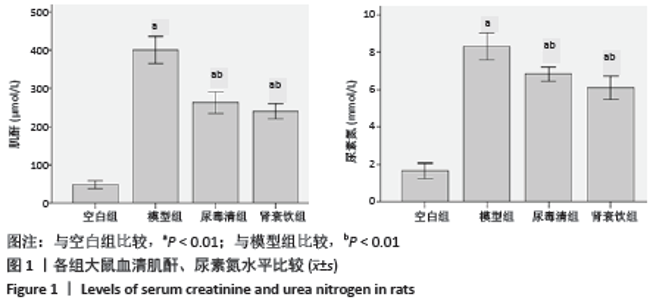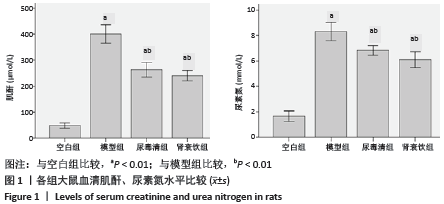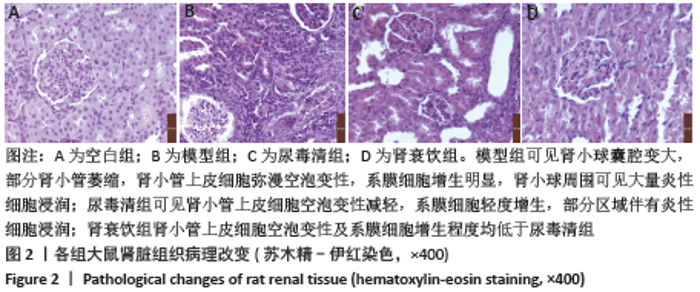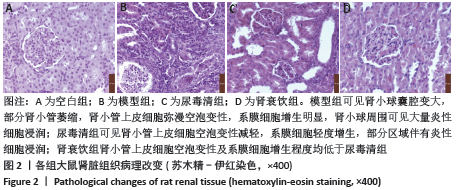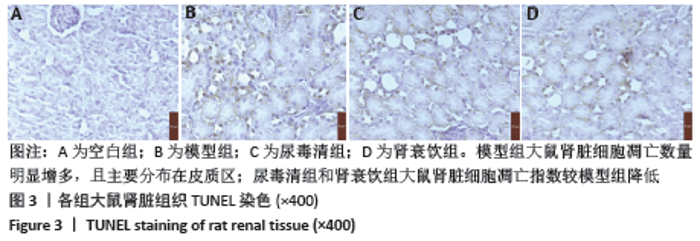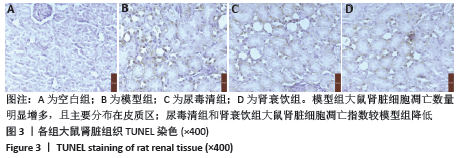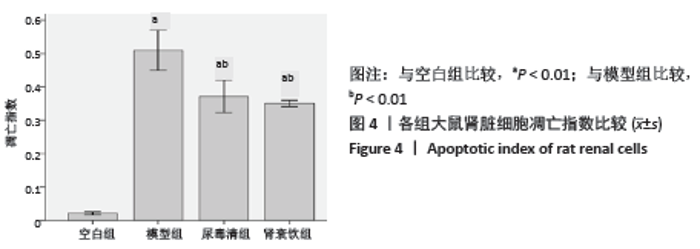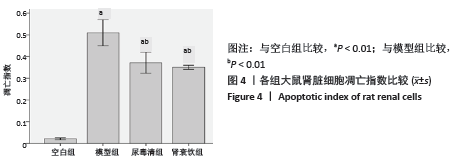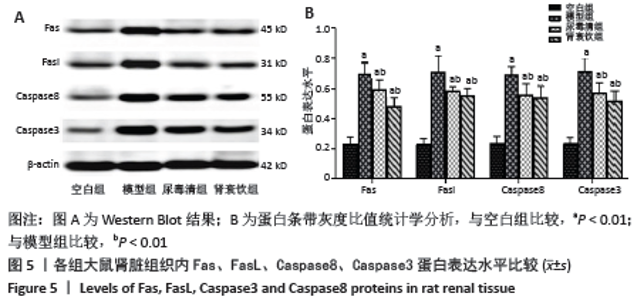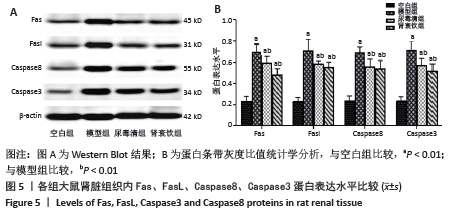[1] 葛均波.“十二五”普通高等教育本科国家级规划教材.内科学[M].北京:人民卫生出版社,2013.
[2] 刘烨,马晓燕.肾衰饮对慢性肾功能衰竭大鼠ATF6/CHOP通路的作用研究[J].中国中医急症,2017,26(5):768-770,796.
[3] 贺丽蓉,邵晓珊,李宇红,等.Fas/FasL在原发性肾小球疾病患儿肾组织中的表达[J].贵州医药,2015,39(3):210-213.
[4] 程丽静,谌贻璞.实验性肾间质纤维化大鼠模型中Fas表达与细胞凋亡[J].中华肾脏病杂志,1999,15(6):340-342.
[5] Yokozawa T, Zheng PD, Oura H, et al.Animal model of adenine-induced chronic renal failure in rat. Nephron. 1986;44(3):230-234.
[6] 王建枝,殷莲华.病理生理学[M].8版.北京:人民卫生出版社,2013.
[7] Wouters OJ, O’Donoghue DJ, Ritchie J, et al. Early chronic kidney disease: diagnosis, management and models of care. Nat Rev Nephrol. 2015;11(8):491-502.
[8] Wyllie AH. Apoptosis (The 1992 Frank Rose Memorial Lecture). Br J Cancer. 1993;67(2):205-208.
[9] Portilla D. Apoptosis,fibrosis and senescence. Nephron Clin Pract. 2014;127(1-4):65-69.
[10] Tanaka T. A mechanistic link between renal ischemia and fibrosis.Med Mol Morphol. 2017;50(1):1-8.
[11] Thomas GL, Yang B, Wagner BE, et al.Cellular apoptosis and proliferation in experimental renal fibrosis.Nephrol Dial. Transplant. 1998;13:2216-2226.
[12] Schelling JR, Nkemere N, Kopp JB, et al. Fas-dependent fratricidal apoptosis is a mechanism of tubular epithelial cell deletion in chronic renal failure. Lab Invest. 1998;78(7):813-824.
[13] Khan S, Cleveland RP, Koch CJ, et al. Hypoxia induces renal tubular epithelial cell apoptosis in chronic renal disease. Lab Invest. 1999;79:1089-1099.
[14] Turan T, Tuncay OL, Usubütün A, et al.Renal tubular apoptosis after partial ureteral obstruction. J Urol. 1994;152(2 Pt 2):658-664.
[15] Nilsson L, Madsen K, Krag S, et al.Disruption of cyclooxygenase type 2 exacerbates apoptosis and renal damage during obstructive nephropathy. Am J Physiol Renal Physiol. 2015;309(12):F1035-F1048
[16] Havasi A, Borkan SC.Apoptosis and acute kidney injury. Kidney Int. 2011;80(1):29-40.
[17] Schumer M, Colombel MC, Sawczuk IS, et al.Morphologic, biochemical, and molecular evidence of apoptosis during the reperfusion phase after brief periods of renal ischemia. Am J Pathol. 1992;140(4):831-838.
[18] Bonegio R, Lieberthal W. Role of apoptosis in the pathogenesis of acute renal failure. Curr Opin Nephrol Hypertens. 2002;11:301-308.
[19] Sugiyama H, Kashihara N, Makino H, et al.Apoptosis in glomerular sclerosis. Kidney Int. 1996;49:103-111.
[20] Cohen AH, Mampaso F, Zamboni L.Glomerular podocyte degeneration in human renal disease. Lab Invest. 1977;37(1):30-42.
[21] Susztak K, Raff AC, Schiffer M, et al. Glucose-induced reactive oxygen species cause apoptosis of podocytes and podocyte depletion at the onset of diabetic nephropathy. Diabetes. 2006;55(1):225-233.
[22] Tharaux PL, Huber TB.How Many Ways Can a Podocyte Die?Semin Nephrol. 2012;32(4):394-404.
[23] Burlaka I, Nilsson LM, Scott L, et al.Prevention of apoptosis averts glomerular tubular disconnection and podocyte loss in proteinuric. Kidney Int. 2016;90(1):135-148.
[24] Steller H. Mechanisms and genes of cellular suicide. Science. 1995;267(5203):1445-1449.
[25] Ortiz-Arduan A, Danoff TM, Kalluri R, et al.Regulation of Fas and Fas ligand expression in cultured murine renal cells and in the kidney during endotoxemia. Am J Physiol. 1996;271(6 Pt 2):F1193-1201.
[26] Zhu Y, Yin X, Li J, et al.Overexpression of microRNA-204-5p alleviates renal ischemia-reperfusion injury in mice through blockage of Fas/FasL pathway. Exp Cell Res. 2019;381(2):208-214.
[27] Hattori T, Shindo S, Kawamura H. Apoptosis and expression of Bax protein and Fas antigen in glomeruli of a remnant-kidney model.Nephron. 1998;79:186-191.
[28] Takemura T, Murakami K, Miyazato H, et al. Expression of Fas antigen and Bcl-2 in human glomerulonephritis. Kidney Int. 1995;48: 1886-1892
[29] Akasaka Y, Ishikawa Y, Kato S, et al. Induction of Fas-mediated apoptosis in a human renal epithelial cell line by interferon-gamma: involvement of Fas-mediated apoptosis in acute renal rejection. Mod Pathol. 1998;11:1107-1114.
[30] Barnhart BC, Alapprt EC, Peter ME. The CD95 Type I/Type II model. Semin Immunol. 2009;15(3):185 -193.
[31] Roy U. Structural characterizations of the Fas receptor and the Fas-associated protein with death domain interactions. Protein J. 2016;35(1):51 -60.
[32] Cho HM, Sun W. Control of mitochondrial dynamics by Fas induced caspase-8 activation in hippocampal neurons. Exp Neurobiol. 2015; 24(3):219 -225.
[33] 张功.马晓燕教授运用肾衰饮加减治疗慢性肾脏病2-4期临床疗效观察[D].沈阳:辽宁中医药大学,2018.
|
